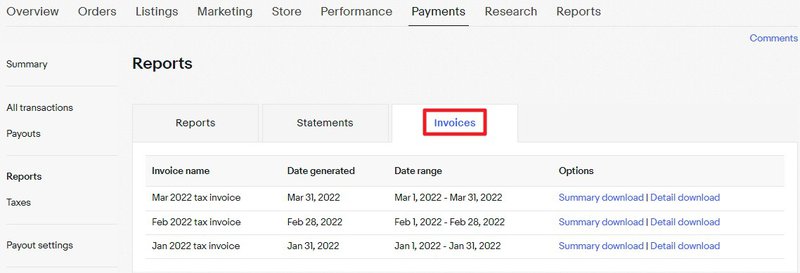The Payments tab in Seller Hub helps you keep track of all the payouts you receive from eBay. Here you can track the money you earn on eBay from the moment the buyer's order is confirmed, to when eBay initiates your payout. In the Summary section, you’ll find an overview of your payment information. For more detailed information, other sections include All transactions, Payouts and Reports.
The Summary section
In the Summary section of the Payments tab, you'll find an overview of your payout information, including your Available, On hold, and Processing funds, recent transactions and payout settings.
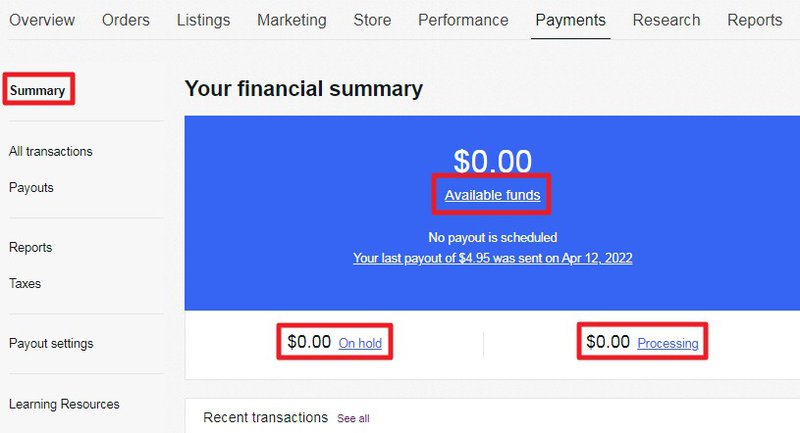
Any transactions processed in a different currency than your payout currency will be converted to your payout currency.
From the Summary section, you can:
- Review your funds: See the status of your Available, On hold, and Processing funds, including the amount in your last payout, and when your next payout is scheduled to be initiated
- Change where or when you get paid: Update the account you receive payouts to, or switch between Daily or Weekly payouts
- Track your transactions: See the recent activity on your account, including information on sales, payouts, shipping labels, and more
If you update your payout account details, your new payout account details may need to be verified before you can continue to receive payouts.
The All transactions section
The All transactions section lists all of your transactions related to payments, including information on sales, refunds, claims, disputes, holds, shipping labels, transfers (funds transferring in or out from your on-file payment method), and payouts.
You can filter your transactions by status, type, dates, or by searching for a specific order ID.
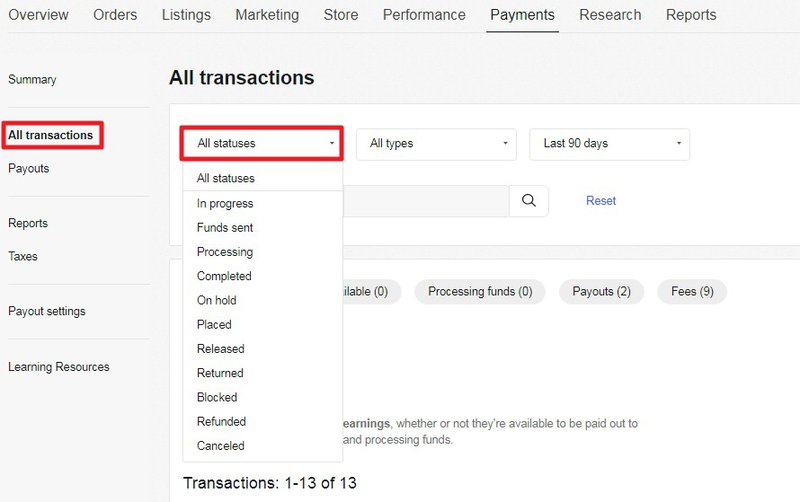
Transaction status
The status of each transaction helps you keep track of your sales activity.
Here’s an explanation of each transaction status:
- Available funds: The amount you will be paid in your next payout. Generally, funds that appear Available are the total of all completed transactions, excluding applicable fees and other selling costs, and any transactions on hold
- Your Available funds may change if eBay processes any additional orders or refunds before your next payout. It may also change if you list any new items as the fees will be deducted from this amount
- Processing: Your buyer has paid and the funds are still processing. As long as the order is confirmed, you can send the item
- On hold: The funds on an order are restricted, for example, the order has an open claim against it. You'll see a reason for the hold and an estimated release date, where possible
- eBay will also provide guidance on how to resolve any outstanding issues with a payment to help you get the funds released. You can find more information about why funds may be placed on hold in this payments on hold article
- Completed: The payment has been processed
- Open: Funds are in dispute, and may be placed On hold
- Released: Funds that were on hold have now been released. These funds will now show in Available funds rather than On hold funds
The Payouts section
The Payouts section provides you with an overview of all your payouts. You can see the total amount of each payout, when it was initiated, the account it was sent to, and how many transactions were included. You can also track the status of your payouts, and search for specific payouts by date, buyer username, order number, or unique payout ID.

You can select the payout ID to see a more detailed breakdown of each transaction in your payout. This includes the status, amount, and fees associated with each transaction, and a link to the order details.
For a detailed explanation of payout statuses, read how payouts work.
The Reports section
From the Reports section, you can download your Transaction report, Payout report, Tax invoice, and Financial statement. eBay provides a detailed breakdown of all your selling activity, so you can make sure your internal records are accurate and up to date.
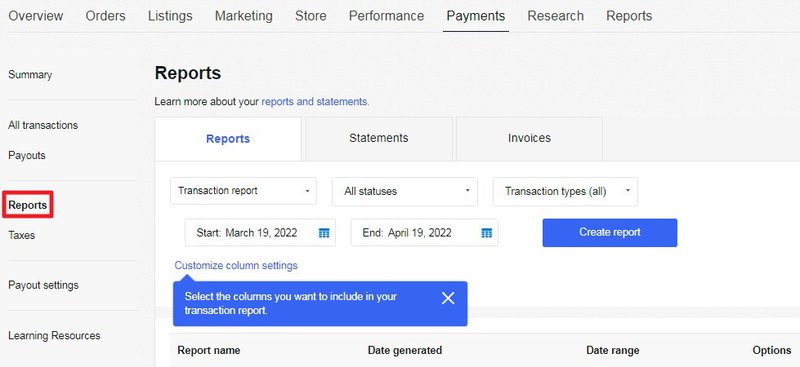
All reports, statements, and invoices will be available to download in Seller Hub. Most files will be in CSV format, which you can open with spreadsheet software such as Microsoft Excel or Google Sheets. However, your financial statement will be in PDF format.
You can use these documents to reconcile your own records with eBay's records. It is recommended to consult your financial advisor for financial reconciling of this information. Below are the documents you can find in Seller Hub, with instructions for downloading each one.
Transaction report
Your transaction report provides a detailed breakdown of all your account activity for a specific date range. It shows details of your transactions, including transaction date, order number, buyer name, payout date, fees, and other information. You’ll be notified by email when your report is available.
⠀⠀
How to download your transaction report:
1. Go to the Payments tab in Seller Hub.
2. From the menu on the left, select Reports.
3. Select the Reports tab.
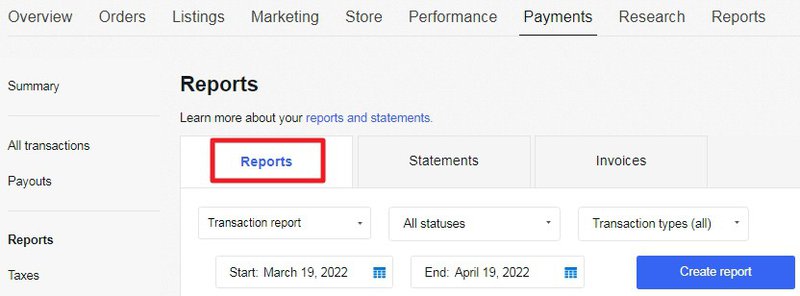
4. Select Transaction report from the dropdown menu.

5. Select the report Type, and the Start and End date.
6. Select Create report.
You can customize your transaction reports by adding or removing columns of information on transactions, payouts, shipping, and items.
How to customize your transaction report:
1. Select the Reports tab in Seller Hub.
2. Select Transaction report from the dropdown menu.
3. Select Customize column settings.
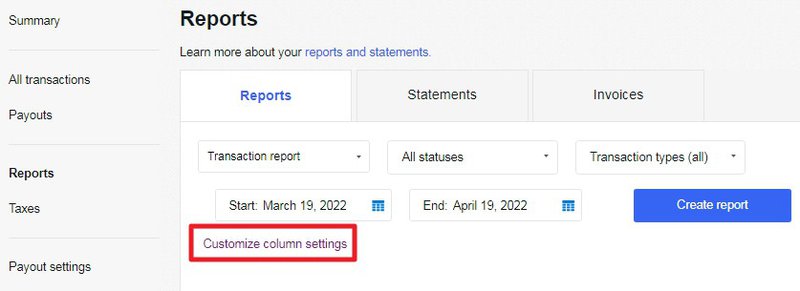
4. Select Transaction details, Payout details, Shipping details or Item details.

5. Select or deselect information for your reports.
6. Select Save.
The times in your transaction report may not match the transaction times in your records due to the differences in international time zones, and may result in discrepancies between your transaction report and other reports.
Below are some of the details you may find in your transaction report, which individually or combined can help you with reconciliation:
- Item ID: The unique ID for your eBay listing
- Payout ID: The unique ID for the payout
- Reference ID: The unique ID for the transaction
- Transaction ID: The unique ID that combines information about a buyer, item, and item price
- Net amount: The net amount you receive for the transaction
- Payout method: The linked account for the payout
- Status: The status of the transaction
- Reason for hold: Additional information about a hold transaction status
- Seller collected tax: Tax collected by the seller on a sold item
- Final value fee: A fee calculated as a variable percentage of the total amount of each sale, plus a fixed amount on each sale. This fee is deducted from your funds before you receive your payout
If any of your funds are On hold, you'll find details in your transaction report.
Payout report
Your payout report provides a summary of your payouts for a specific date range.
⠀⠀
How to download your payout report:
1. Go to the Payments tab in Seller Hub.
2. From the menu on the left, select Reports.
3. Select the Reports tab.

4. Select Payout report from the dropdown menu.

5. Select the Start and End date.
6. Select Create report next to the report you would like to download.
The reports you request will be saved for 90 days. After that, you’ll need to request them again using the instructions above.
Payout dates are unlikely to exactly match the dates in the financial statement for your payout account due to the processing time for eBay and your financial institution.
Financial statement
Your financial statement provides a summary of your monthly account activity. Every month, you’ll receive an email to let you know that your financial statement is ready to download. In your financial statement, you’ll find a summary of your selling activity and a detailed view of your transactions, including information on claims, refunds, payment disputes, payouts and more for that month.
⠀⠀
How to download your financial statement:
1. Go to the Payments tab in Seller Hub or Payments in My eBay.
2. Select Reports.
3. Select the Statements tab.

4. Select Download next to the statement you would like to download.

5. Select Summary or Full statement.
Monthly statements are available to download for 10 years. The statement is not an invoice and does not replace existing reports.
You can find a record of your fees and credits in your monthly financial statement, or by downloading a transaction report. These are both available in Seller Hub.
Invoice
Your invoice is issued for services rendered and includes all applicable seller fees and other costs. Every month you’ll receive an email to let you know your invoice is available to download. Your Invoice shows you the applicable taxes on fees and other costs already deducted from your Available, Processing, and On hold funds. If you sell on multiple eBay sites, you'll see the fees and taxes grouped by currency.
Billing cycles
eBay generates all financial statements on the 1st of the month, which will cover activity from the 1st to the last day of the calendar month. The mid-month cycle for invoices and financial statements won’t be supported any longer. For more information, please read the most frequently asked questions and answers on billing cycles below.
FAQ
Why does eBay have to move my billing cycle in order to change the date I receive my reports?
eBay wants to help streamline the reporting and reconciliation processes for sellers by aligning all payments reporting to the calendar month.
Can I choose not to make this move?
Moving forward, the marketplace will not be supporting the mid-month cycle for invoices and financial statements, so eBay encourages you to update your processes in preparation for this change.
Can I move back to the mid-month cycle?
No, this change is intended to make seller reconciliation and reporting processes easier. In the future, eBay will not be supporting the mid-month cycle for invoices and financial statements.
How does this change impact my tax reporting?
Please inform your tax advisor or accountant about this change.
What about the month when this change took effect? Were there two invoices/financial statements?
There was a 16-day transition period spanning the end of the previous mid-month cycle and the beginning of the next cycle. Sellers received a separate invoice and financial statement covering this period. After that, 30-day tax invoice and financial statement are sent at the beginning of each month. These changes took effect on May 01, 2022.
For example:
- You received your invoice and financial statement on or around March 16 for sales from February 16 — March 15
- You received another invoice and financial statement on or around April 1 with sales from March 16 — March 31
- Going forward, you'll receive your invoice and financial statement at the start of each month (May 1, June 1, etc.) detailing your activity in the prior month
Will all my historical invoices and financial statements be changed to the beginning of the month?
You can download reports, statements, and invoices of your orders, fees, and payouts in Seller Hub, and then reconcile these documents with your own records to make sure that everything matches up.
